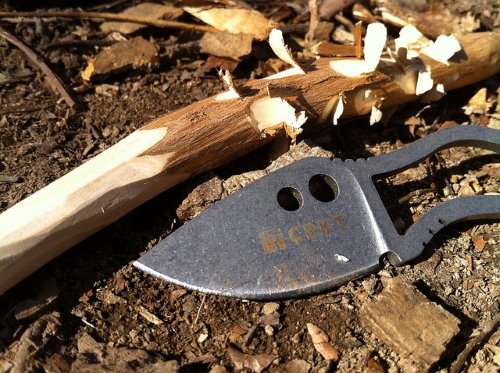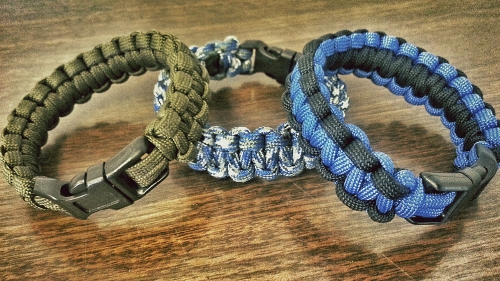It would be so convenient if you could carry all your survival gear with you every day, but dragging a bug-out bag everywhere is impractical. There are a few essential items you can pop into a regular backpack, just in case the unthinkable happens.
A good knife is a must-have for survival.
Knife
The first item is an easy one: the knife has been the main tool of survival for millennia, and it’s still a great choice. It can be used for hunting, digging, peeling bark, building or even self-defense. When putting a knife in your backpack, choose one you’re comfortable with so it won’t feel awkward when you need to use it. Know how to sharpen it, keep it clean and handle it without endangering yourself or others. If you travel with your backpack, know the laws regarding acceptable knife length and storage methods.
Water Purification Tablets
Water is essential for life. You can exist for days without food, but you won’t last long without water. Bottled water makes a backpack heavy and bulky, and there’s the chance of leaks. Water purification tablets, however, are almost weightless, take up much less space and can be used to create safe drinking water from streams, springs and other free-flowing sources. Tablets are usually made with iodine or chlorine, and have a limited life once they are opened.
There are also non-chemical water filters like the LifeStraw, which can be reused but has a limited store life of a few years. Whichever method you choose, read all the instructions carefully when you pack your backpack, and occasionally check the integrity of the container.
Paracord bracelets are stylish and handy.
Paracord Bracelet
Emergency bracelets made with paracord are the latest trend, and they come in a wide variety of colors. Their main purpose is to provide you with a strong, light length of rope in emergency or survival situations. While they are easy to find, make sure you’re getting real 550 military spec paracord when you buy a bracelet, and it should contain at least ten feet of cord. Use them to build a shelter, create a net trap for wild game, make a splint or tourniquet, tie your supplies up on a high branch, and other survival scenarios.
Portable Shelter
Think you don’t have room for a tent in your backpack? Think again. While there are some great money management tips for saving emergency funds, keep that cash aside for other survival gear needs and create a make-do shelter by measuring out several feet of clear plastic sheeting. Bring the two ends together and create a large tube by sealing the plastic together with a warm iron set on “low.”
For best results, use tissue paper between the iron and plastic. Once it’s cooled, fold the tube into the smallest square possible, wrap it in foil or a small bag and pop it into your backpack. In an emergency, you can slip the paracord through it, tie the cord between two trees so the tube hangs down to the ground, and you have a quick shelter from the elements for sleeping or resting.
Food
It seems like a no-brainer to keep food in your bag for emergencies, but you need to select edibles that keep well under adverse conditions and provide you with maximum nutritional benefits, like protein trail bars or even a couple of MREs (Meals Ready to Eat) if you have the space. MREs take up more room, but since they were originally developed for the military, they are amazingly shelf-stable at extreme temperatures and come with their own safe heating devices so you can have a hot meal.
Protein or meal bars take up less space, cost less but may need to be switched out of your bag more often due to expiration dates. Whatever food items you choose, include a small bag of corn chips. Not only are they tasty, but they contain oil and a few chips make decent firestarters.
Space in your backpack is always limited, so consider creating a tiny essentials kit for your backpack as well. If you’ve ever seen mints or throat lozenges in a small tin box, then you’ve seen the perfect container for assembling a go-anywhere survival kit. Include waterproof matches, Band-Aids, a small tube of your preferred antibiotic or treatment cream for first aid, needle, thread, safety pins, fishing line and a couple of cotton balls.
You can also buff the paint or print off the outside until the box shines, and use the outside as a signaling mirror when needed. This kit will give you the very basic tools for first aid, repairs, fishing and starting fires. You can even seal the box with wax or drop it into a weatherproof bag to keep the contents dry and fresh.
Source: doomsdaymoose.com
Other useful resources:
Blackout USA (EMP survival and preparedness guide)
Backyard Innovator (All Year Round Source Of Fresh Meat,Vegetables And Clean Drinking Water)
Conquering the coming collapse (Financial advice and preparedness )
Liberty Generator (Easy DIY to build your own off-grid free energy device)
Backyard Liberty (Easy and cheap DIY Aquaponic system to grow your organic and living food bank)
Bullet Proof Home (A Prepper’s Guide in Safeguarding a Home )
Family Self Defense (Best Self Defense Strategies For You And Your Family)
Sold Out After Crisis (Best 37 Items To Hoard For A Long Term Crisis)
Beth Bartlett writes about business, travel and modern culture for magazines and websites.
Photo credits:Mike Petrucci and GA-Kayaker


Actually, the Lifestraw has changed its limited shelf-life to INDEFINITE. So it is NOT a thing that has to be replaced if not used after 5 years… It can be stored, pretty much forever… Just a heads up on that. I feel bad for all the people who have bought them and threw them out only to buy new ones when the originals were still good.